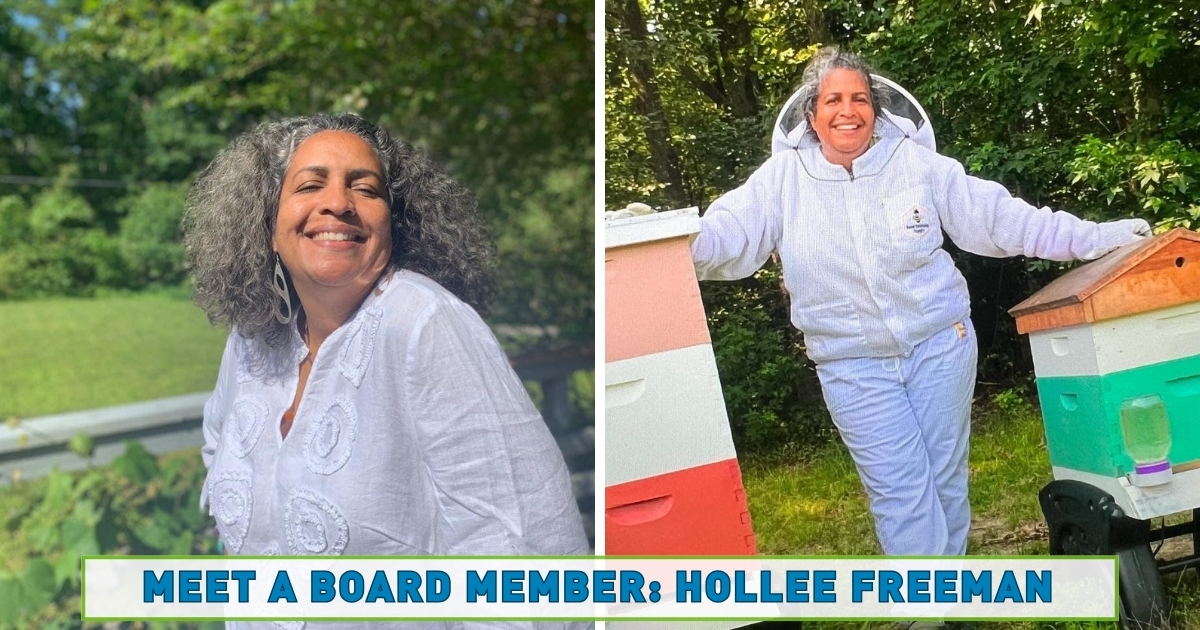We’re thrilled to have Dr. Hollee Freeman on our Board at Capital Trees. Her personal and professional passions line up closely with the work we are trying to accomplish throughout the City of Richmond. Hollee is an author, educator, and beekeeeper who strives to bring people closer to the natural world. Read our interview with Dr. Hollee Freeman below to learn more about what Capital Trees initiatives she’s excited about, what brought her to our Board, and her favorite greenspaces in the city.
Q. When and how did you learn about the work Capital Trees does throughout RVA?
A. I learned about Capital Trees through Frazier Millner-Armstrong when she was the ED there. We went on walks together where she talked about the work of Capital Trees and the Low Line.
Q. What inspired you to want to be on the Capital Trees Board?
A. Capital Trees works to bring people into a closer relationship with nature by having nature around and in the city, and this is akin to my own personal and professional mission. I knew that Capital Trees had a dynamic board with members representing different areas of focus. In addition, I like the idea of working outside during volunteer days and talking with community members as part of my personal board service.
Q. What skill set, knowledge, professional experience, or unique perspective do you bring to the Board?
A. I am invested in the health of the metro Richmond community through a better relationship with people, nature and even ourselves. I have a significant focus on STEM (science, technology, engineering and mathematics) that I bring to my board work. I am also a beekeeper and see the importance of educating the community on not just planting trees and flowers but also, how to help our pollinators thrive — which helps with garden and crop production and ultimately, the food that we put on our tables.
Q. In your own words, why do you think urban greenspaces are a vital resource?
A. Urban greenspaces are a vital resource because they provide the emotional and psychological respite we need in order to reorder the energy in our bodies. I wrote a poem recently for the Capital Regional Land Conservancy and one of the lines is: “…a nervous system regulated in the color green.” I believe that just being in nature can soothe our souls and bring us into a state of peace and connection. Also, the physical benefits of urban greenspaces cannot be left unsaid. These spaces encourage walking, bike riding, community gardening and talking to people that you pass — people that you may never look at, much less talk to in other settings. These spaces have the power to heal and transform lives in a myriad of ways.
Q. What Capital Trees contribution or project are you most proud of or excited about?
A. I am excited about Bee City, which Capital Trees board members have had a significant hand in moving through the city vetting process with others in the coalition. I am looking forward to being in the conversation and helping to develop programs that will protect and build native habitats for insects and being a part of the education of this important work to the community.
Q. What should more people know about Capital Trees?
A. The board and staff at Capital Trees is thinking critically and deeply about how to fulfill its mission for all of the citizens of the Metro Richmond Region. We don’t take this work lightly and encourage community members to get involved.
Q. What do you feel is Capital Trees biggest need?
A. I feel that Capital Trees needs to continue to support and encourage volunteerism around the projects that we offer.
Q. What are you most looking forward to in the next year or over your Board Term?
A. I am looking forward to more action-oriented conversations with the board and community members where the outcome is a concrete project or initiative.
Q. How do you foresee the organization transforming in the coming years?
A. I foresee the organization becoming increasingly more diverse in terms of the skills and dispositions that members bring to the organization, as well as more racial/cultural diversity with increased partnerships with likely and unlikely partners.
Q. What’s your favorite plant/plot/project of Capital Trees?
A. I love walking along the Low Line. It’s beautiful with the interesting juxtaposition of an active train line, river and nature in the same space. The plantings are growing beautifully and there seems to be so much joy on the faces of people using the Low Line.
Q. What is your favorite public landscape/greenspace?
A. I love being at the Sankofa Community Orchard. The greenspace abutting Reedy Creek holds over 80 fruit trees, fruiting shrubs and flowers on 5 acres of space on the Southside of Richmond. In addition, the murals depicting BIPOC agricultural and other activists, community work days, garden talks, City Bees Apiary and more add to the inspiration of the space.


